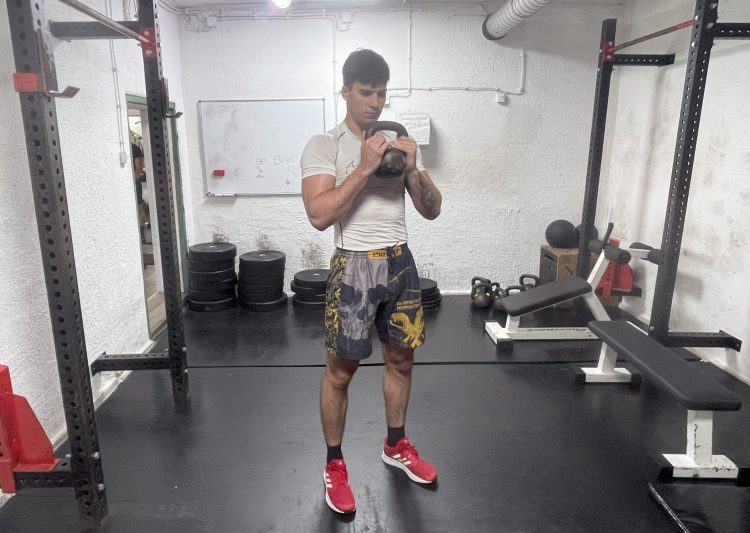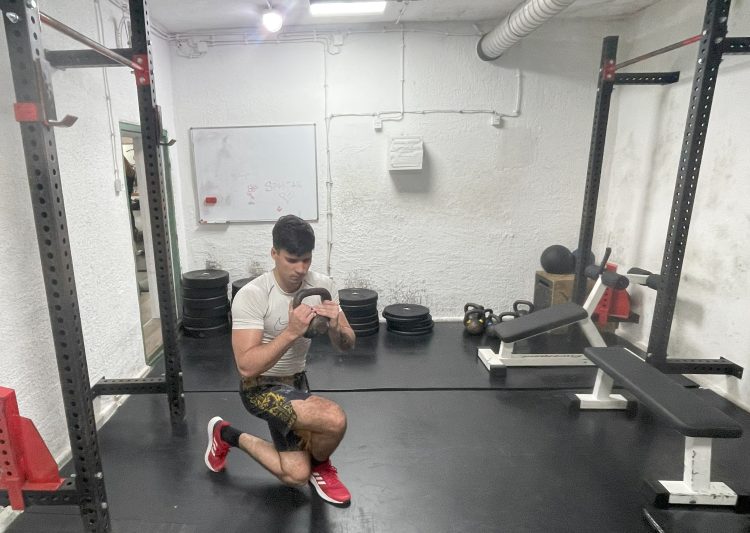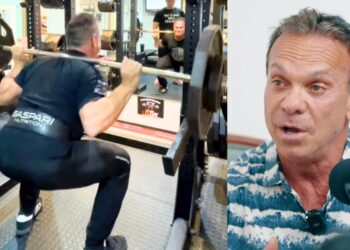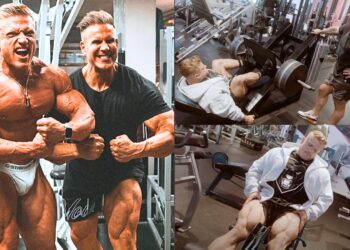A curtsy squat is a grueling squat-lunge hybrid that biases the glutes and upper legs. This exercise gets its name from the traditional curtsy greeting, which involves bowing your head, stepping back with one foot, and bending the knee.
Curtsy squats can help correct lower body strength and muscle imbalances while improving coordination and balance. They also require substantial core activation, making them a holistic strength and conditioning exercise that should be a part of your exercise arsenal.
In this article, I share everything you need to know to master the curtsy squats.
How To Do a Curtsy Squat
Here is a step-by-step guide to performing the curtsy squats:
Step One — Assume the Starting Position
Hold a kettlebell in the goblet position and assume a shoulder-wide stance. Your knees should be fully extended, your back flat, and your eyes looking straight ahead.
Level Up Your Fitness: Join our 💪 strong community in Fitness Volt Newsletter. Get daily inspiration, expert-backed workouts, nutrition tips, the latest in strength sports, and the support you need to reach your goals. Subscribe for free!
Pro Tip: Experiment with gym equipment other than kettlebells, such as dumbbells, sandbags, and medicine balls. It will vary the muscle activation patterns, adding to the overall versatility of the workout.
Step Two — Step Your Right Leg Diagonally Behind Your Body
Lift your right foot off the floor and move it diagonally behind your body as far as you comfortably can. Place the ball of your right foot on the floor while your left foot should be fully grounded.
Flex your front knee, hips, and ankles to lower toward the floor until your rear knee gently touches the floor. Hold the bottom position for one second. Ensure your torso is upright throughout the exercise.
Pro Tip: Lean forward for a deeper glutes and hamstrings stretch. To emphasize your quads more, keep your torso upright and perpendicular to the floor throughout the exercise.
Step Three — Return to the Starting Position
Reverse the motion to return to the starting position. Repeat on the other side. Alternate between sides for the desired reps.
Pro Tip: Brace your core to keep your torso upright and avoid losing balance.
Watch Vanja Vukas perform the Curtsy Squat:
In a YouTube Video, Danny Matranga, a certified personal trainer and corrective exercise specialist, shares tips for performing curtsy squats to maximize performance:
“As you step back, slightly turn your foot inwards. This will help reduce knee strain. For even better results, keep your body upright at the bottom of the movement rather than stepping too far back and leaning forward.”
Curtsy Squat Muscles Worked
The primary muscles are the gluteus medius and maximus, quads, and adductors, whereas the hamstrings, calves, core, and erector spinae are the secondary muscles.
Curtsy Squat Benefits
Below are the most important benefits of curtsy squats:
Improved Glute Development
Curtsy squats are excellent for targeting the glutes. This is important because the gluteus maximus is one of the primary trunk stabilizers in the sagittal plane of motion.
In contrast, the gluteus medius, together with adductors, helps with frontal plane stabilization. Improved glute strength will reduce knee pain and the chance of knee injuries while improving athletic performance. (1)
Quad Activation
Curtsy squat is a holistic lower body exercise that effectively targets glutes, hamstrings, quadriceps, adductors, and calves. Due to its unilateral nature, it is extremely effective at improving balance and coordination.
Implementing curtsy squats at least once in your weekly leg workout programming can help you develop lower body functional strength and stability and promote hypertrophy.
Level Up Your Fitness: Join our 💪 strong community in Fitness Volt Newsletter. Get daily inspiration, expert-backed workouts, nutrition tips, the latest in strength sports, and the support you need to reach your goals. Subscribe for free!
Enhanced Core Stability, Balance, and Coordination
Curtsy squats will improve your overall trunk and core stability. The movement requires substantial ab and hip muscle activation to keep your body stable. Since this is a unilateral lower-body exercise, it requires a significant amount of balance and coordination and can help fix muscle and strength imbalances.
Curtsy squats keep your rectus abdominis, obliquus internus, obliquus externus, and transversus abdominis active throughout the exercise.
Curtsy squats can be used to tackle specific muscle imbalances in your lower body. To maximize muscle stimulation, alternate sides with each rep.
You can also perform a fixed number of reps on one side before transitioning to the other, but there is a catch. Since curtsy squats (and other lunging exercises) are extremely demanding, there is a chance you won’t put the same effort into both sides. Keeping this in mind, you should always start the set with your weaker side if you choose to do all the reps on one side first.
Here is something to consider if you are dealing with an injury. Cross-education occurs after training one side of the body, leading to improved performance in the untrained opposite limb. (2)
This means you can leverage curtsy squats during post-injury physical therapy sessions to restore certain functions and levels of strength in your injured limb. That said, you must consult your healthcare provider before starting any new training program if you are injured or recovering.
Curtsy Squat Variations and Alternatives
Check out the best curtsy squat variations and alternatives:
Reverse Lunges
Reverse lunges can be tough on your lower body because they put a lot of stress on your posterior chain muscles and adductors. However, they are excellent for improving your overall stamina and lower body functionality.
Steps:
- Hold a kettlebell in the goblet position.
- Begin the exercise by stepping back with your right leg while bending your front leg to lower your body toward the ground.
- Stop just before your rear knee touches the ground and hold that position for one second.
- Reverse the motion to return to the starting position and repeat with your left leg.
Pro Tip: Keep your torso upright and core engaged to maintain balance and maximize glute and quad activation.
Bulgarian Split Squats
Bulgarian split squats are one of the most challenging unilateral lower-body exercises.
Steps:
- Place a weight bench or a stepper behind you.
- Position the top of your left foot on the elevated object.
- Ensure your right leg is forward enough so you have enough space to lower your body toward the floor without interruptions.
- Bend your right knee and lower your left knee toward the ground.
- Hold the bottom position for one second.
- Reverse the motion to return to the starting position.
- Repeat for the recommended reps before switching legs.
Pro Tip: To improve balance and muscle engagement during Bulgarian split squats, place your front foot far enough forward so that your knee stays behind your toes during the descent. Maintain an upright torso to increase stability and maximize quad and glute engagement.
FAQs
How many reps of curtsy lunges should I do?
For endurance, aim for over 12 reps per set. For muscle growth, do eight to 12 reps. For strength and power, one to six reps at a high percentage of your 1RM.
Why are curtsy lunges so challenging?
Curtsy squats are challenging because they require strength, endurance, precision, and coordination to execute the movement correctly. Some of my personal training clients either have weak posterior chain muscles or adductors, which makes the exercise much harder and taxing for them.
What are some common curtsy lunges mistakes?
Common form errors during curtsy lunges include too much torso rotation, poor posture, limited movement range, misaligned knees, and failure to engage the core.
Wrapping Up
The curtsy squat is an excellent lower-body exercise for improving coordination, muscle gains, strength, and endurance. Adding curtsy squats to traditional lower-body workouts helps improve stability and builds functional strength in each leg.
I usually perform curtsy squats at least once weekly to ensure holistic lower body development.
In the comments below, let me know your thoughts on curtsy squats and how you implement them in your workouts.
References:
- McClinton SM, Cobian DG, Heiderscheit BC. Physical Therapist Management of Anterior Knee Pain. Curr Rev Musculoskelet Med. 2020;13(6):776-787. doi:10.1007/s12178-020-09678-0
- Andrushko JW, Lanovaz JL, Björkman KM, Kontulainen SA, Farthing JP. Unilateral strength training leads to muscle-specific sparing effects during opposite homologous limb immobilization. J Appl Physiol (1985). 2018;124(4):866-876. doi:10.1152/japplphysiol.00971.2017
Relevant Articles:
Interested in measuring your progress? Check out our strength standards for Bulgarian Split Squat, Reverse Lunge, Squat, and more.










